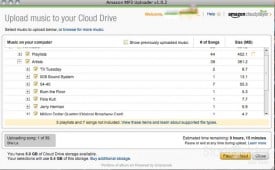
Earlier this week they announced the Android Appstore (review), and now they’ve announced Cloud Drive and Cloud Player. Also, not to be forgotten: your Girlfriend may also now live in the cloud too. No word if this will also work for wives.
The concept is simple: upload your music collection to the “cloud” and then access it anywhere on any Android device or PC. No word yet on iPhone/iPod support. Still this is clearly a move to bolster their MP3 store, and take another step towards aggregating a content service (music/movies/podcasts/e-Books) that can go toe-to-toe with the industry stalwart iTunes.

Clicking “upload music” prompts you to install the Amazon MP3 Uploader. A nice feature: it automatically scans your computer for all music files and asks if you want to upload everything. It’s a one click operation. On my MacBook Pro I only have about 360MB of music, mostly random stuff. My real collection is on the media server we use to stream through the house. It took about 15 minutes to upload this smaller library to the Cloud Drive.
The interface itself is quite PC – as in old-school directory structure. The default configuration comes with four folders: Documents, Music, Pictures, Videos. This should be pretty explanatory stuff. You can create new folders, upload content and move it around.
You have two options to access music: Cloud Player for Web and Cloud Player for Android. The Android app is essentially the MP3 app (v. 1.8.29) that you likely already have installed on your smartphone. For example, I believe it comes as a default on the Droid (which these days feels incredibly slow) so I was able to use it without any download or setup.

One side benefit of using the service is that you get an automatic backup of your collection. If your house burns down while listening to Burn The Floor at least you know your music is safe! How important that is to you relative to things like family heirlooms, insurance policies, financial records, and that over-loaded wine cellar is, of course, a matter of personal preference.
So the big question: Will you store your music in the cloud?

